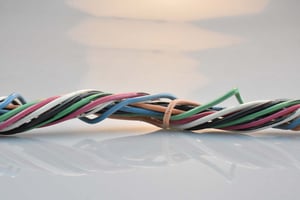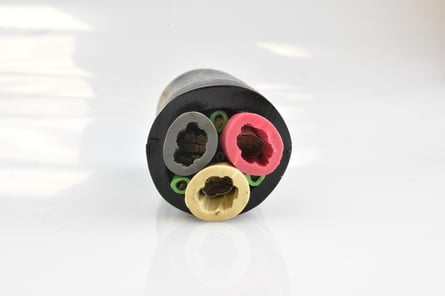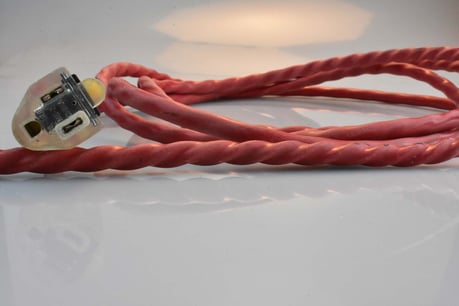 Your cable has failed! Your operation has come to a halt and every minute down is costing your operation resources. Even though you cannot turn back time, you can help prevent costly downtime in the future by understanding why your cable has failed.
Your cable has failed! Your operation has come to a halt and every minute down is costing your operation resources. Even though you cannot turn back time, you can help prevent costly downtime in the future by understanding why your cable has failed.
Selecting the appropriate cable for your harsh industrial environment is vital to your operation. Let’s look at six common types of cable failure modes.
Six Types of Cable Failure Modes
1. Conductor FailuresOpen Conductor - Conductors can sever or break, leading to a loss of continuity. Causes might include repeated flexing over a tight bend radius or tick-tock type motion, incorrect or too tight of a bend radius, or extreme tension on the cable.
High Resistance of Conductor - Prior to a conductor severing, a stranded conductor will most likely initially see individual strands break. As individual strands break, the resistance of the conductor will increase. This can lead to two possible failure modes: 1) The conductor strands will continue to break until a complete break occurs, or 2) The higher resistance will begin to create heat and will eventually overheat causing a localized burn point leading to a break in the conductor.
Cracks/Perforations - Types of insulation failure can include cracks or perforations of the insulation material. Cracks in insulation material may be caused by continued constant bending over a tight radius. The insulation material becomes fatigued and eventually fails. Perforation of insulation material can occur if conductor strands begin to break or sever and perforate the insulation wall.
Foil Shields - Foil shields tend to break down over time when put through repeated bending/flexing motions. The foil shields start to crack, eliminating their purpose within the cable.
Copper Braid Shields - Copper braid shields may become mechanically fatigued especially when placed under torsional or twisting type motion.
4. Jacket Failures
Jacketing protects the inner conductors and cable components from the external environment. It receives the most abuse from mechanical, chemical, and effects of weather.
Cracking/Swelling - Exposure to certain oils, chemicals, or fluids may result in the jacket material having a negative reaction. Depending on the chemical, this can lead to the jacketing either swelling up and becoming soft and easily torn or becoming hard and brittle leading to cracking.
Abrasion - Failure of the outer jacket due to abrasion occurs when the outer jacket wears through exposing the cable core. Failures of this type occur when the cable is applied in applications that will abrade the cable. This can occur if the cable is dragged across the ground, applied in an application with constant rubbing motion against the cable, or improper installation onto equipment.
Cuts/Cut-through - Impact or contact with sharp objects can lead to cuts in the jacket. Minor cuts that are only superficially on the jacket typically do not impact cable performance. Cuts that impair jacket performance or penetrate down to the shield or cable core are a reason for either repair or replacement of the cable.
5. Corkscrewing Failures
 Excessive Tension - Excessive tension on the cable can cause the conductors to be pulled out of their “lay.” Once conductors are pulled out of their lay, they are no longer properly configured within the cable build, and the cable will begin to corkscrew. This may lead to the cable core puncturing through the jacket.
Excessive Tension - Excessive tension on the cable can cause the conductors to be pulled out of their “lay.” Once conductors are pulled out of their lay, they are no longer properly configured within the cable build, and the cable will begin to corkscrew. This may lead to the cable core puncturing through the jacket.
Bend Radius - Too tight of a bend radius will lead to cable corkscrewing. It is important to follow the cable manufacturers' recommended minimum bend radius.
Insufficient Spacing in Cat-Tracks -Installing cables without proper spacing in cat-tracks can cause cables to corkscrew. If the cables are not provided with enough room to freely move in the track, corkscrewing may occur.
Cable Alignment - If the cable is not properly aligned within an application, for example using multiple pulleys, deformation of the cable can occur.
Open or Loss of Continuity - An open conductor (or loss of continuity) of a conductor will result in loss of power or signal data.
Short - A short circuit can occur should conductor strands break and perforate the insulation wall and come into contact with a shield or strands from other broken conductors. Shorts can occur from conductor-to-conductor or conductor-to-shield. Depending on the location of the short and the application, this can lead to loss of signal or data, or a brief moment of excessive current leading to conductor or cable damage.
Shielding Losses/EMI-RFI issues - Should the foil and/or braid shield sustain damage, the cable may become more susceptible to EMI/RFI noise issues. This can result in lost or corrupt data.
Current Overload - If ampacity is not properly addressed, the cable may overheat at the conductor. This can lead to extreme heat build-up, compromising the integrity of the insulation material and jacketing material. In extreme cases, the cable may burn and become flammable.
Let our team of experts lead you through choosing the right cable for your application. ATPC works closely with our customers to provide specific wire and cable solutions, including custom-designed wire and cable products and in-house engineering expertise. We can tackle your toughest application challenges to create a customized solution that is perfect for your application. Contact an ATPC representative today to help select the right cable and wire for the job.


